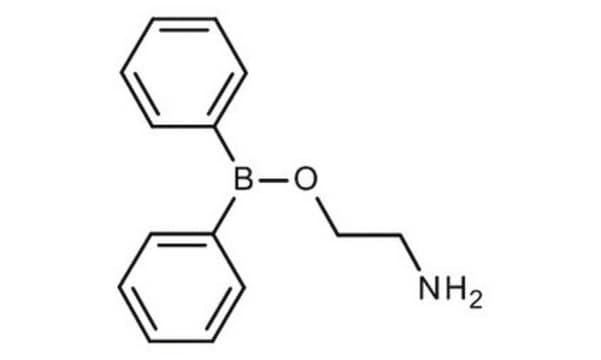100065
2-APB
≥97% (titration), crystalline solid, Ins(1,4,5)P3-induced Ca2+ release inhibitor, Calbiochem®
Synonim(y):
2-APB, 2-Aminoethoxydiphenylborate, (2-Aminoethoxy)diphenylborane
About This Item
Polecane produkty
product name
2-APB, A cell-permeable modulator of Ins(1,4,5)P3-induced Ca2+ release.
Poziom jakości
Próba
≥97% (titration)
Postać
crystalline solid
producent / nazwa handlowa
Calbiochem®
warunki przechowywania
OK to freeze
desiccated (hygroscopic)
kolor
white
rozpuszczalność
DMSO: 20 mg/mL
95% ethanol: 25 mg/mL
Warunki transportu
ambient
temp. przechowywania
2-8°C
InChI
1S/C14H16BNO/c16-11-12-17-15(13-7-3-1-4-8-13)14-9-5-2-6-10-14/h1-10H,11-12,16H2
Klucz InChI
BLZVCIGGICSWIG-UHFFFAOYSA-N
Opis ogólny
Działania biochem./fizjol.
Ins(1,4,5)P3-induced Ca2+ release
Opakowanie
Ostrzeżenie
Rekonstytucja
Inne uwagi
Gregory, R.B., et al. 2001. Biochem. J.354, 285.
Ma, H.T., et al. 2001. J. Biol. Chem.276, 18888.
Ascher-Landsberg, S., et al. 1999. Biochem. Biophys. Res. Commun.264, 979.
Maruyama, T., et al. 1997. J. Biochem.122, 498.
Informacje prawne
Hasło ostrzegawcze
Warning
Zwroty wskazujące rodzaj zagrożenia
Zwroty wskazujące środki ostrożności
Klasyfikacja zagrożeń
Eye Irrit. 2 - Skin Irrit. 2 - STOT SE 3
Organy docelowe
Respiratory system
Kod klasy składowania
11 - Combustible Solids
Klasa zagrożenia wodnego (WGK)
WGK 3
Temperatura zapłonu (°F)
Not applicable
Temperatura zapłonu (°C)
Not applicable
Certyfikaty analizy (CoA)
Poszukaj Certyfikaty analizy (CoA), wpisując numer partii/serii produktów. Numery serii i partii można znaleźć na etykiecie produktu po słowach „seria” lub „partia”.
Masz już ten produkt?
Dokumenty związane z niedawno zakupionymi produktami zostały zamieszczone w Bibliotece dokumentów.
Klienci oglądali również te produkty
Nasz zespół naukowców ma doświadczenie we wszystkich obszarach badań, w tym w naukach przyrodniczych, materiałoznawstwie, syntezie chemicznej, chromatografii, analityce i wielu innych dziedzinach.
Skontaktuj się z zespołem ds. pomocy technicznej
















